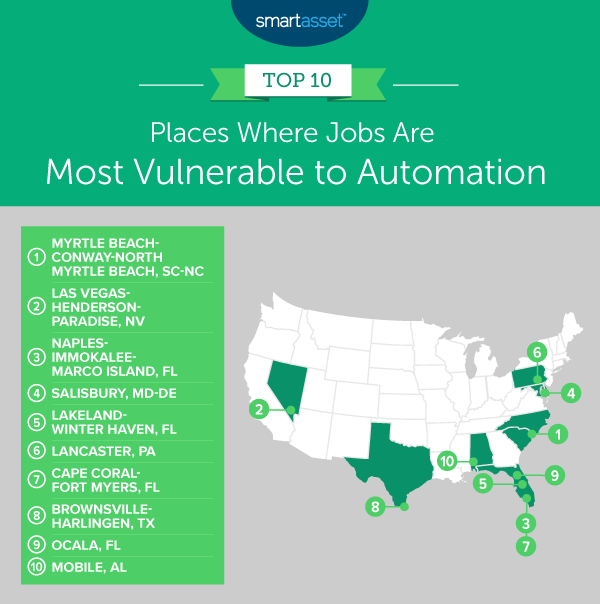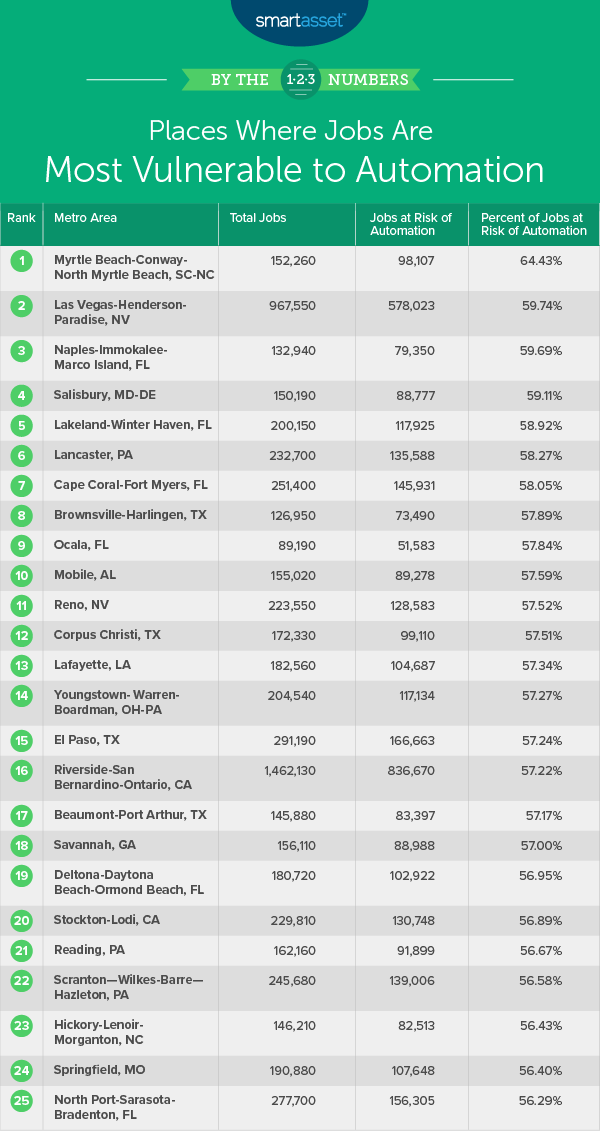
An estimated 47% of jobs in the U.S. are vulnerable to automation, according to a 2013 paper written at Oxford University by researchers Carl B. Frey and Michael A. Osborne. Depending on the mix of knowledge, skills and abilities an occupation requires as well as the variety of tasks it involves, certain jobs will be more susceptible to automation than others, which could hurt workers’ potential to save enough to support themselves. According to the researchers’ findings, some popular occupations most vulnerable to automation include tax preparers, real estate brokers, cashiers and secretaries and administrative assistants. All four of those occupations have over a 95% chance of computerization according to their findings.
In SmartAsset’s study this year, we used Frey and Osborne’s findings to understand which places in the U.S. have the greatest percentage of jobs vulnerable to automation. To rank the places where jobs are most vulnerable to automation, we looked at two factors: the risk of automation in each occupation based on the aforementioned Oxford paper and the number of people working in different occupations in each metro area. We used these metrics to compute the percentage of jobs at risk for each of the 150 locations we analyzed. For more information on our data and how we put it together, check out our Data and Methodology section below.
This is our first study on the metro areas where jobs are most vulnerable to automation. To see our previous findings on the states where jobs are most vulnerable to automation, read our 2018 study here.
Key Findings
- Automation and wages. As noted in Frey and Osborne’s paper, there is a strong negative correlation between an occupation’s risk of computerization and the median income for that occupation. This correlation is very present in our rankings. Of the top 10 places with the biggest percentage of jobs at risk to automation, all but one of them rank in the bottom third of the metropolitan areas in terms of median annual income, as reported by the Census Bureau.
- Retail salespersons, cashiers and waiters and waitresses. For many of the places where jobs are most susceptible to automation, retail salespersons, cashiers and waiters and waitresses are popular jobs. All three occupations have over a 90% chance of automation and require no advanced education.

1. Myrtle Beach-Conway-North Myrtle Beach, SC-NC
Encompassing counties in both South Carolina and North Carolina, Myrtle Beach-Conway-North Myrtle Beach has the largest percentage of jobs vulnerable to automation of any of the 150 biggest metropolitan areas in the U.S. We estimate that nearly two in three jobs in Myrtle Beach-Conway-North Myrtle Beach are vulnerable to automation within the next decade or two. Specifically, of the total 152,260 jobs reported in 2018 by the Bureau of Labor Statistics, 98,107 are at risk.
Jobs most at risk in Myrtle Beach-Conway-North Myrtle Beach include retail salespersons, cashiers and waiters and waitresses. In 2018, there were 9,670 retail salespersons, 7,530 cashiers and 7,740 waiters and waitresses employed in Myrtle Beach-Conway-North Myrtle Beach. Given each of these occupation’s probability of automation, together they account for almost 23,500 of the total jobs at risk.
2. Las Vegas-Henderson-Paradise, NV
In our study on job automation by state, Nevada ranked first. Unsurprisingly, Las Vegas-Henderson-Paradise, Nevada ranks high when looking at metro areas. It employs the greatest number of workers by far of any metropolitan area in our top 10. In 2018, almost one million workers were employed in Las Vegas-Henderson-Paradise, which means it has at least 700,000 more total jobs than any other place in our top 10. Those opportunities could be in part why Henderson is the 10th most popular city where millennials are moving.
Of the 967,550 jobs in Las Vegas-Henderson-Paradise, 59.74% are susceptible to computerization. While the percentage of jobs at risk is lower in Las Vegas-Henderson-Paradise than Myrtle Beach-Conway-North Myrtle Beach by almost 5%, the number of jobs that would be lost in the Las Vegas area far surpasses the number potentially lost in the Myrtle Beach area. Specifically, in Myrtle Beach-Conway-North Myrtle Beach, 98,107 jobs are at risk while in Las Vegas-Henderson-Paradise, 578,023 jobs are at risk. Those looking for other career opportunities may be interested in learning about the fastest-growing jobs in each state.
3. Naples-Immokalee-Marco Island, FL
Just south of Fort Myers, Naples-Immokalee-Marco Island, Florida follows closely behind Las Vegas-Henderson-Paradise in terms of the percentage of jobs vulnerable to automation. We estimate that 59.69% of jobs in Naples-Immokalee-Marco Island are at risk. However, Naples-Immokalee-Marco Island employs significantly fewer individuals than Las Vegas-Henderson-Paradise. In 2018, there were a total of 132,940 jobs, about 830,000 fewer than the total number of jobs in Las Vegas-Henderson-Paradise.
Like Myrtle Beach-Conway-North Myrtle Beach, the jobs most at risk in Naples-Immokalee-Marco Island are retail salespersons, cashiers and waiters and waitresses. In 2018, there were 6,380 retail salespersons, 5,640 waiters and waitresses and 4,770 cashiers employed in Naples-Immokalee-Marco Island. Together, the three occupations account for 19.92% of the jobs at risk.
4. Salisbury, MD-DE
Consisting of four counties, Somerset, Wicomico and Worcester in Maryland and Sussex in Delaware, Salisbury employs more than 150,000 people. The most popular jobs in Salisbury include retail salespersons, cashiers and combined food preparation and service workers (including fast food). In 2018, there were 6,690 retail salespersons, 6,300 cashiers and 4,750 combined food preparation and service workers in Salisbury. While retail salespersons and combined food preparation and service workers are slightly less susceptible to automation than cashiers, all three occupations have a greater than 90% chance of computerization.
Two common jobs that have a low risk of automation in Salisbury are general and operations managers and first-line supervisors of office and administrative support workers. Both jobs have less than a 20% chance of automation. In 2018, 1,810 general and operation managers and 1,800 first-line supervisors of office and administrative support workers in Salisbury.
5. Lakeland-Winter Haven, FL
Located in central Florida, Lakeland-Winter Haven is the second metro area in Florida in our top 10. Lakeland-Winter Haven employed more than 200,000 workers in 2018. The three most popular occupations in Lakeland-Winter Haven – laborers and freight, stock and material movers; retail salespersons and cashiers – are all at significant risk of automation.
Workers at risk of automation in Lakeland-Winter Haven may want to consider the fields of education or general and operations management. Both fields have lower automation probabilities and are already significant industries in Lakeland-Winter Haven.
6. Lancaster, PA
Lancaster, Pennsylvania employs the third-greatest number of people of any metropolitan area in our top 10. In 2018, there were a total of 232,700 jobs in Lancaster. Of those jobs, 135,588 are at risk. The two occupations most at risk in terms of gross number are retail salespersons and office clerks, which have a 92.31% and 95.55% chance, respectively, of being automated. In 2018, there were 8,180 retail salespersons and 7,170 office clerks in Lancaster.
Lancaster is the only place in our top 10 with a median income than does not rank in the bottom third of all metropolitan areas considered, though it still ranks in the bottom half for this metric. The median annual income in Lancaster in 2018 was $36,380. In comparison, the average median annual income across all 150 metro areas in 2018 was $37,906.
7. Cape Coral-Fort Myers, FL
Following Las Vegas-Henderson-Paradise, Cape Coral-Fort Myers, Florida has the second-greatest number of jobs at risk of any metropolitan area in our top 10. We estimate that almost 150,000 jobs of the total 251,400 jobs in Cape Coral-Fort Myers are at risk of being automated. While 150,000 is much less than the estimated almost 600,000 jobs at risk in Las Vegas-Henderson-Paradise, it is still significant.
Like many other places in our top 10, the top three vulnerable jobs in Cape Coral-Fort Myers are retail salespersons, waiters and waitresses and cashiers. Almost 30,000 jobs are expected to be lost should those occupations be automated.
8. Brownsville-Harlingen, TX
Brownsville-Harlingen has the lowest-ranking median income of any metropolitan area of the 150 areas we considered. According to the Bureau of Labor Statistics Occupational Employment Statistics Survey, in 2018 the median income in Brownsville-Harlingen was $24,550, about $13,300 less than the average median annual income across all cities. Given the negative relationship between computerization probability and wages and the low median income in Brownsville-Harlingen, it is unsurprising that many of the jobs in Brownsville-Harlingen are at risk of automation. We estimate that 57.89% jobs in Brownsville-Harlingen are susceptible to computerization.
9. Ocala, FL
Ocala, Florida has the smallest workforce of any place in our top 10. In 2018, there were 89,190 workers in Ocala. We estimate that almost 58% of jobs in Ocala, Florida are at risk of automation, which translates to a gross number of 51,583 jobs at risk.
Ocala’s most popular occupation is retail salespersons. In 2018, there were 4,600 retail salespersons in Ocala, at least 650 more workers than in any other occupation. The second- and third-most popular occupations in Ocala most at risk for automation are cashiers and combined food preparation and serving workers (including fast food). In 2018, there were 3,950 cashiers and 3,730 combined food preparation and serving workers in Ocala. Given each occupation’s risk of automation, we estimate that the three occupations together account for more than 11,500 jobs at risk in Ocala, or about 22% of the total jobs at risk.
10. Mobile, AL
The last place in our top 10, Mobile, Alabama, still has a much higher percentage of jobs at risk compared to the percentage of jobs at risk in the U.S. overall. We estimate that, like Ocala, almost 58% of jobs in Mobile are vulnerable to automation. In comparison, an estimated 47% of jobs in the U.S. overall are vulnerable to automation.
The most popular occupations in Mobile are retail salespersons, combined food preparation and serving workers (including fast food) and registered nurses. In 2018, there were 6,500 retail salespersons, 5,260 combined food preparation and serving workers and 5,100 registered nurses in Mobile. While retail salespersons and combined food preparation and serving workers are both very susceptible to automation – an approximately 92% chance in either occupation – registered nurses are fairly safe in terms of job security.

Data and Methodology
In order to finds the places were jobs are most vulnerable to automation, we looked at data for the biggest 150 metro areas in the U.S. Specifically, we compared them across the following two metrics:
- Total workers in occupations. This is the total number of workers in occupations for which we had data. Data comes from the Bureau of Labor Statistics and is from 2018.
- Susceptibility of jobs to automation. This is the percentage chance an occupation will become automated over an unspecified number of years. Researchers say a decade or two is an appropriate timeline. Data comes from research done at Oxford University. Specifically, “The Future of Employment: How susceptible are jobs to computerization?” by Carl B. Frey and Michael A. Osborne, published in 2013.
We multiplied the number of jobs in each occupation by the chance they will be automated for each metropolitan area. The metropolitan area with the highest percentage of jobs at risk of automation scored first, while the metropolitan area with the lowest percentage of jobs at risk of automation scored last.
Tips for Avoiding Financial Stress
- Commit to a budget. Committing to a detailed and strict budget can help you avoid spending more than you are able and avoid future stressful financial situations.
- Get financial help. A financial advisor can help you make smarter financial decisions such as moving or being in better control of your money after you land a new job. Finding the right financial advisor that fits your needs doesn’t have to be hard. SmartAsset’s free tool matches you with financial advisors in your area in 5 minutes. If you’re ready to be matched with local advisors that will help you achieve your financial goals, get started now.
Questions about our study? Contact us at press@smartasset.com
Photo credit: ©iStock.com/gorodenkoff